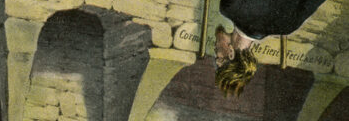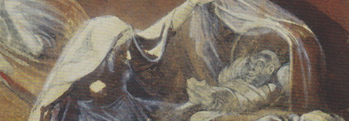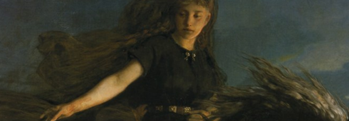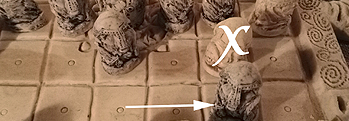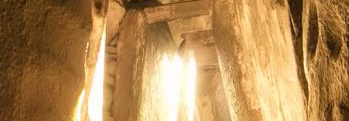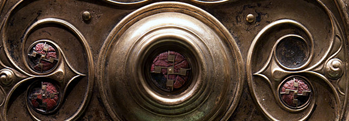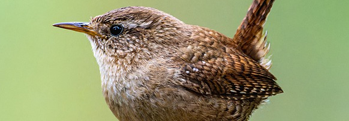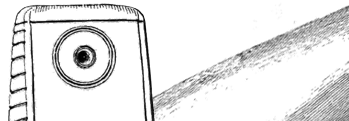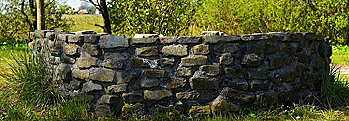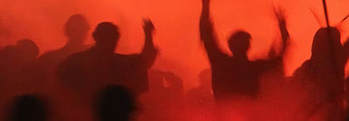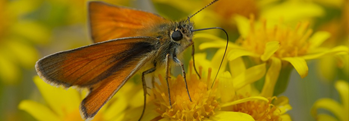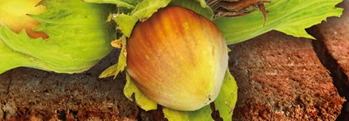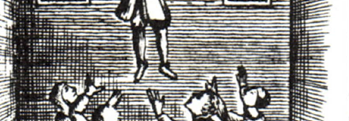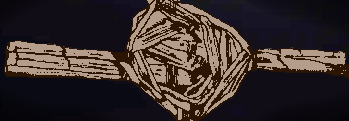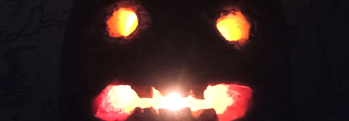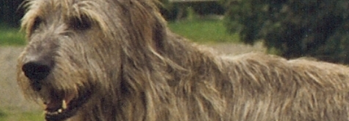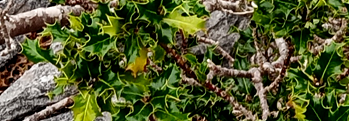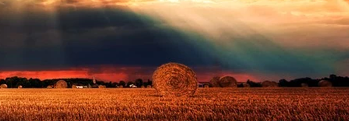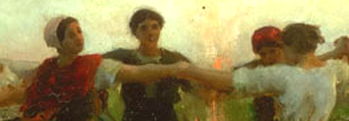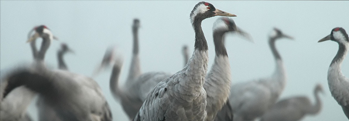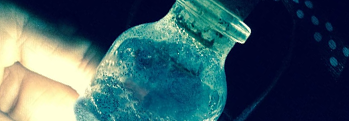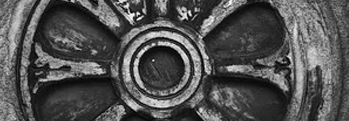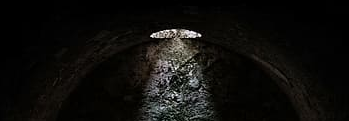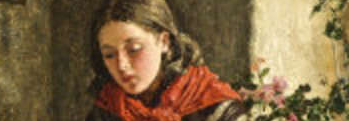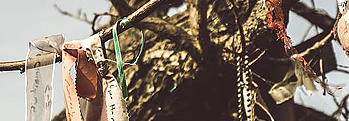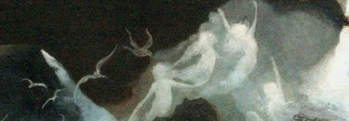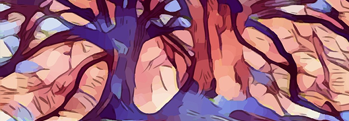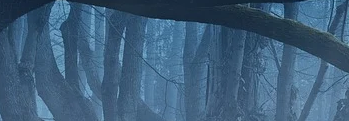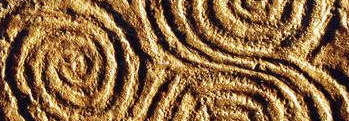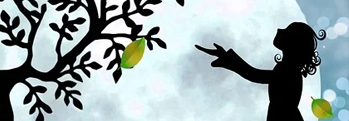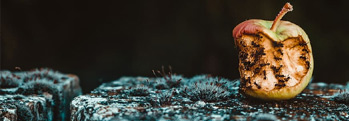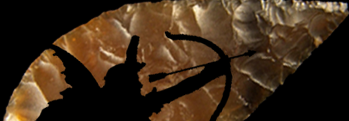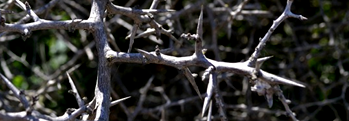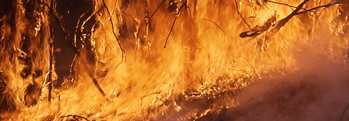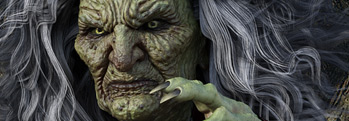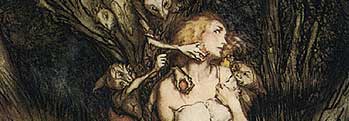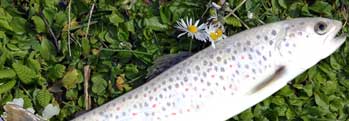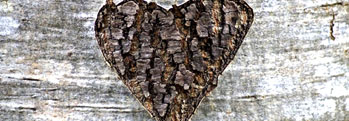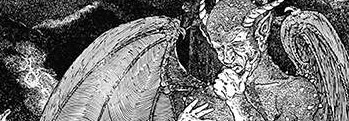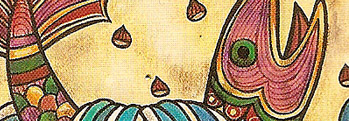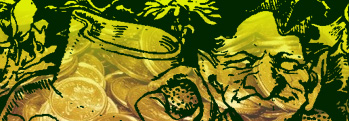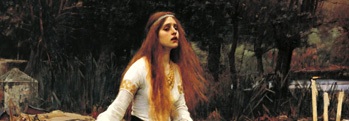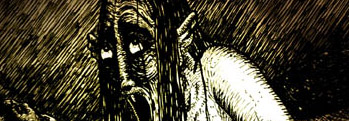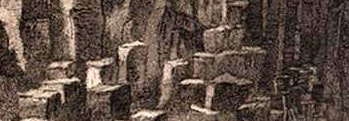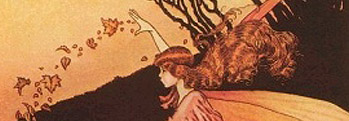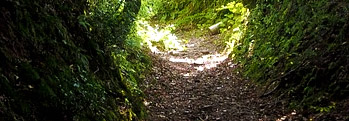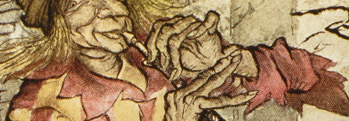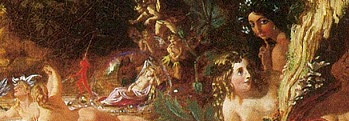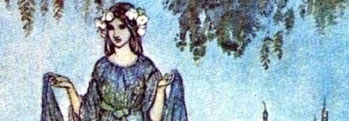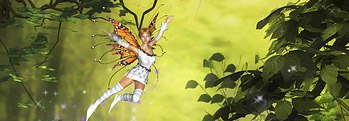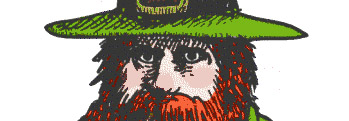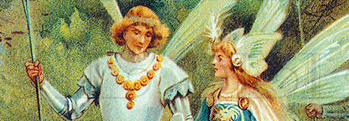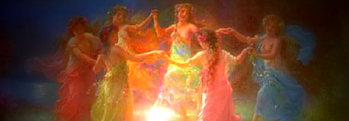Fairy Forts
Irish and Celtic myths and legends, Irish folklore and Irish fairy tales tales of Ireland
Ancient dwellings still respected today, Fairy Forts
There are a great many raths or fairy forts of old scattered throughout Ireland today, numbering in the tens of thousands, and it is here, the wise say, that the good people or fairy folk gather to hold their revels.
Nobody would dare to cross, let alone build on a fairy dwelling in the past, marking as they did the boundary between our civilised world and the wild Otherworld. To trespass on their land was to risk a beating or worse, for the fairies were known to hold great grudges against families.
As a scholar in the 1910s wrote after speaking to a local farmer:
 “I now asked John what sort of a race the ‘good people’ are, and where they came from, and this is his reply: ‘People killed and murdered in war stay on earth till their time is up, and they are among the good people. The souls on this earth are as thick as the grass (running his walking-stick through a thick clump), and you can’t see them; and evil spirits are just as thick, too, and people don’t know it…The old folk saw the good people here on the Hill a hundred times, and they’d always be talking about them. The good people can see everything, and you dare not meddle with them. They live in raths, and their houses are in them.”
“I now asked John what sort of a race the ‘good people’ are, and where they came from, and this is his reply: ‘People killed and murdered in war stay on earth till their time is up, and they are among the good people. The souls on this earth are as thick as the grass (running his walking-stick through a thick clump), and you can’t see them; and evil spirits are just as thick, too, and people don’t know it…The old folk saw the good people here on the Hill a hundred times, and they’d always be talking about them. The good people can see everything, and you dare not meddle with them. They live in raths, and their houses are in them.”
In the 1950s the government of Ireland tried to build a road through a fairy fort, but the workers threw down their tools and refused, despite all benefits and bonuses offered to continue their work. When a politician suggested building a fence around the rath, the man responsible for the road decided it would be a bad idea, as he wryly said, “Next the fairies would come looking for pensions!”
And even to this day it's not considered the best course of action to interfere with these ancient places, as the sorry tale of Seán Quinn, once Ireland's wealthiest man, testifies from the Irish Independent:
“He was once Ireland’s richest man, with a fortune of €4.7bn, before his huge gamble on Anglo Irish Bank shares toppled him into bankruptcy. But for some…the downfall of Séan Quinn has more to do with the wrath of the fairies than risky business moves. According to these locals, it was the decision to move a megalithic burial tomb 20 years ago which led to the fall of his cement, hotels, and insurance empire…Following a full excavation of the site, it was moved—stone by stone—and relocated in the grounds of Mr. Quinn’s Slieve Russell Hotel on the other side of the village.
Mr. Quinn has since lost the cement works, the hotel, a raft of other businesses and his multi-billion euro fortune. According to bankruptcy documents, he now claims to have just €11,000 in the bank…’I’m a big supporter of Séan Quinn because of what he has done for this area but that tomb should never have been moved,’ said publican Toirbhealach Lyons, the owner of Molly Maguire’s pub in Ballyconnell.”
Here are some accounts of fairy forts and the strange events surrounding them, recorded a century gone past now by Lady Gregory in her efforts to preserve the ways and stories of the country people.
A Miller:
As to the three lisses at Ryanrush, there must have been a great deal of fighting there in the old time. There are some bushes growing on them and no one, man or woman, will ever put a hand to cut them, no more than they would touch the little bush by the well beyond, that used to have lights shining out of it.
And if any one was to fall asleep within the liss himself, he would be taken away and the spirit of some old warrior would be put in his place, and it's he would know everything in the whole world. There's no doubt at all but that there's the same sort of things in other countries. Sure these can go through and appear in Australia in one minute. But you hear more about them in these parts, because the Irish do be more familiar in talking of them.
Enchanters and magicians they were in the old times, and could make the birds sing and the stones and the fishes speak.
It's in the forts they mostly live. The last priest that was here told us a lot about them, but he said not to be anyway afraid of them, for they are but poor souls doing their penance.
Mary Nagle:
That's a fine big liss at Ryanrush, and people say they hear things there, and sometimes a great light is seen - no wonder these things should be seen there, for it was a great place for fighting in the old centuries, and a great deal of bones have been turned up in the fields. There was an open passage I remember into the liss, and two girls got a candle one time and went in, but they saw nothing but the ashes of the fires the Danes used to make. The passage is closed up now I believe, with big stones no man could lift.
One time a woman from the North came to our house, and she said a great deal of people is kept below there in the lisses; she had been there herself, and in the night-time in one moment they'd all be away at Cruachmaa, wherever that may be, down in the North I believe. And she knew everything that was in the house, and told us about my sister being sick, and that there was a hurling going on, as there was that day at the Isabella wood in Coole.
And all about Coole House she knew as if she spent her life in it. I'd have picked a lot of stories out of her but my mother got nervous when she heard the truth coming out, and bid me be quiet. She had a red petticoat on her, the same as any country woman, and she offered to cure me, for it was that time I was delicate and your ladyship sent me to the salt water, but she asked a shilling and my mother said she hadn't got it.
"You have," says she, "and heavier metal than that you have in the house." So then my mother gave her the shilling, and she put it in the fire and melted it, and says she, "After two days you'll see your shilling again." But we never did. And the cure she left, I never took it; it's not safe, and the priests forbid us to take their cures - for it must surely be from the devil their knowledge comes. But no doubt at all she was one of the Ingentry, that can take the form of a woman by day and another form at night.
After that she went to Mrs. Quaid's house and asked her for a bit of tobacco. "You'll get it again" she said, "and more with it." And sure enough, that very day a bit of meat came into Mrs. Quaid's house.
Maurteen Joyce:
There's a fort near Clough that wanders underneath, but a man couldn't get into it without he'd crawl on his hands and knees. Well, Kennedy's filly was brought in there, and lived there for five days without food but what she got from them, and no one knew where she was till a man passing by heard her neighing and then she was dug out.
There's a fort near our house, but it's not the good people that are in it, only the old inhabitants of Ireland shut up there below.
There are a few old forts about, some of them you mightn't notice unless you understood such things; but sometimes passing by you'd feel a cold wind blowing from them, would nearly rend you in two.
When I was a young chap myself I used to see a white woman walking about sometimes at midday - that's the worst hour there is - and she'd always go back into a fort, and fort of Cahir near Cloonmore, and disappear into it.
She was known to be a woman that had died nine years before; and she would sometimes come into the sister's house, and bid her keep it clean. But one time the sister's husband went to burn the inside of the fort, and the next morning his barn where he had all the wheat of the harvest and near a ton of hay and two or three packs of wool, was found to be on fire. And his own little girl, about eight years of age, was in the barn, and a labouring man broke through and brought a wet cloth with him and threw it over her and carried her out But she was as black as cinders and dead. Vexed they were at him burning the fort.
An Old Miller:
Did they get help to make those forts? You may know well that they did. There was an engineer here when that road was being made-a sort of an idolater or a foreigner he was-anyway he made it through the fort, and he didn't last long after. Those other engineers, Edgeworth and Hemans beyond at Ardrahan when the railway was made, I'm told they avoided such things.
A Slieve Echtge Man:
There were two brothers taken away sudden, two O'Briens. They were cutting heath one day and filling the cart with it, and a voice told them to leave off cutting the heath, but they went on, and a blow struck the cart on the axle. And soon after that one of the brothers sat down in his chair and died sudden. And the other was one day going to market, I was going to it that day myself, and he wasn't far beyond the white gate when the axle of the cart broke in that same place where it had got the blow, and so he had to go home again, and near the river where they're cutting the larch he turned in to talk to a poor man that was cutting a tree, and the tree fell, and top of it struck him and killed him. And it was last March that happened.
There was one Leary in dough had the land taken that's near Newtown racecourse. And he was out there one day building a wall, and it was time for his dinner, but he had none brought with him. And a man came to him and said "Is it home you'll be going for your dinner?" And he said "It's not worth my while to go back to dough, I'd have the day lost." And the man said, "Well, come in and eat a bit with me." And he brought him into a fort and there was everything that was grand, and the dinner they gave him of the best, so that he ate near two plates of it. And then he went out again to build the wail. And whether it was with lifting the heavy stones I don't know, but (with respects to you) when he was walking the road home he began to vomit, and what he vomited up was all green grass.
A Man on the Connemara Coast:
This is a faery stream we're passing; there were some used to see them by the side of it, and washing themselves in it. And there used to be heard a faery forge here every night, and the hammering of the iron could be heard, and the blast of the furnace.
There is a faery hill beyond there in the mountain, and some have seen fires in it all through the night. And one time the police were out there still - hunting, and the head of them, one Rogers, was in the middle of that place, and there he died, no one could say how, though some of his men were round about him.
That's a nice flat clean place that rock we're passing - that's the sort of place they'd be seen dancing or having their play.
A Piper:
I knew twin sons, Considines, and one was struck with madness in England, and one at home - Pat in England Mike in Connacht - at the one time. Both were sent to Ballinasloe Asylum, and got well in eight months, and that was ten year ago, and one of them is married and rearing a family. The mother used to be doing cures with herbs; it is likely that is the reason but she gave it up after they were struck.
There were three of another family went in to the Asylum, one this year, one next year, and one the year after, and no reason but that their house was close to the side of a fort.
Maurteen Joyce:
When I was in Clare there was a fort, and two or three men went down it one time, and brought rushes and lights with them. And they came to where there was a woman washing at a river and they heard the crying of young lambs, and it November, for when we have winter, there is summer there. So they got afraid, and two of the men came back, but one of them stopped there and was never heard of after. The best of things they have, and no trouble at all but to be eating; but they have no chance of being saved till the Day of Judgment.
I knew another fort that two men watched, and at night there came out of it two troops of horses, and they began to graze. But when the men came near them they made for the forts, and all they got was a foal. And they kept it, and it was a mare-horse, and it had foals, and the breed was the best that was ever seen m the country.
Mrs. Leary:
There did strange things happen in that wood, noises would be heard, and those that went in to steal rods could never get them up on their back to bring them away. But there was one man said whatever happened he'd bring them, and he got them on to his back, and then they were lifted off it over the wood. But they fell again and he got them and carried them away; I suppose they thought well of him having so much courage.
Cruachmaa is the great place for them.
A man who had lost a blood mare met an old man from a fort who said "Put your right foot on my right foot." And he did so, and at once he saw the blood mare and his foal close by.
The Old Man Who Was Making a Well:
There was a man and his wife was brought away at Cruachmaa and he was told to go dig, and he'd get her out. And he began to dig, and when he had a hole made at the side of the hill he saw her coming out, but he couldn't stop the pick that he had lifted for the stroke, and it went through her head.
J. Doran:
Whether they are in it or not, there are many tell stories of them. And I often saw the half of Cruachmaa covered - like as if there was a mist on it.
But one side of a wall is luckier than another, all the old people will tell you that there was a big Stone in the yard behind our house and my husband thought to blast it, for it was in the way, and my mother said "I'm in the house longer than you, and take my advice and never touch that stone," and he never did. But there was a man built a house close by and he wanted to close a passage, and one morning he came early and was laying hands on that stone to take it. But I was out when I heard him and drove him away. And the house never throve with him, he lost two or three children, and then he died himself.
A Gate-keeper:
At St. Patrick's well at Burren there used to be a great pattern every year. And every year there was something lost and killed at it, a horse or a man or a woman.
So at last the priest put a stop to it. And there was an old woman with me in the barracks at Burren, and she told me she remembered well when she was a young girl and the time came when the pattern used to be, the first year it was stopped her father put her up on a big high wall near the well, and bid her look down. And there she saw the whole place full of the gentry, and they playing and dancing and having their own games, they were in such joy to have done away with the pattern. I suppose the well belonged to them before it got the name of St. Patrick.
There's a small little house not far down the road where they used to be very fond of going. And a woman in the town asked the old woman that lived in it what did they look like. And she said "For all the world like people coming in to Chapel."
There was a girl coming back here one time from Clough, and instead of coming here she went the Esserkelly road and was led astray and a man met her and says he, "why do you say you're going to Labane and it's to Roxborough you're facing?" and he turned her around. And when she got home she took off the bundle she had on her back, and what jumped out of it but a young hare.
Mrs. Casey:
I have a great little story about a woman - a jobber's wife that lived a mile beyond Ardrahan. She had business one time in Ballyvaughan, and when she was on the road beyond Kinvara a man came to her out of a fort and he asked her to go in and to please a child that was crying. So she went in and she pleased the child, and she saw in a corner an old man that never stopped from crying. And when she went out again she asked the man that brought her in, why was the old man roaring and crying. The man pointed to a milch cow in the meadow and he said, "Before the day is over he will be in the place of that cow, and it will be brought into the fort to give milk to the child." And she can tell herself that was true, for in the evening when she was coming back from Ballyvaughan, she saw in that field a cow dead, and being cut in pieces, and all the poor people bringing away bits of it, that was the old man that had been put in its place. There is poison in that meat, but no poison ever comes off the fire, but you must mind to throw away the top of the pot.
The fort where I heard the talking long ago, and left my can, it's only the other day I was telling Pat Stephens of it that has the land. And he told me he put a trough in it to catch the water about a month ago. And the next day one of his best bullocks died.
Mrs. O'Brien:
It's a bad piece of the road that poor boy fell off his cart at and was killed. There's a fort near it, and it's in that fort my five children are that were swept from me. I went and I told Father Carey I knew they were there, and he said "Say your prayers, my poor woman, that's all you can do." When they were young they were small and thin enough, they grew up like a bunch of rushes, but they got strong and stout and good-looking. Too good they were, so that everyone would remark them and would say, "Oh, look at Ellen O'Brien-look at Catherine - look at Martin! So good to work and so handsome, so loyal to their mother." And they were all taken from me, it never was in my family or in the father's, and how would they all gone now but one. Consumption they were said to get, but get it without some provocation? Four of them died with that, and Martin was drowned. One of the little girls was in America and the other at home, and they both got sick, and at the end of nine months both of them died.
Only twice they got a warning. Michael that was the first to go was out one morning very early to bring a letter to Mr. Crowe. And he met on the road a small little woman, and she came across him and across him again, and then again, as if to be humbugging him. And he got afraid, and told me about her when he got home. And not long after that he died.
And Ellen used to be going to milk the cow for the nuns morning and evening, and there's a place she had to pass, a sort of enchanted place, I forget the name of it. And when she came home one evening she said she'd go there no more, for when she was passing that place she saw a small little woman, with a little cloak about her, and her face not the size of a doll's face. And with the one look of her she got a fright and ran as fast as she could, and sat down to milk the cow. And when she was milking she looked up, and there was the small little woman coming along by the wall. And she said she'd never like to go up there again.
So to move the thought out of her mind I said "Sure that's the little woman is stopping up at Shamus Mor's house." "Oh, it's not, Mother," said she; "I know well by her look she was no right person." "Then my poor girl you're lost," says I, "for I know it was the same woman that my husband saw." And sure enough, it was but a few weeks after that she died. There wasn't much change in them before their death, but there was a great change after.
And Martin, the last that went, was stout and strong and nothing ailed him, but he was drowned. He'd go down some-times to bathe in the sea and one day he said he was going, and I said, "Do not, for you have no swim."
But a boy of the neighbours came after that and called to him, and I was making the little dinner for him, and I didn't see him from the door. And I never knew he was gone till when I went out of the house the girl from next door looked at me some way strange, and then she told me two boys were drowned, and then she told me one of them was my own. Held down he was, they said, by something under water. They had him followed there.
It wasn't long after he died I woke one night and I felt some one near, and I struck the light and then I saw his shadow. He was wearing his little cap but under it I knew his face and the colour of his hair. And he never spoke and he was going out the door and I called to him and said "Oh, Martin, come back to me and I'll always be watching for you." And every night after that I'd hear things thrown about the house outside, and noises. So I got afraid to stop in it, and went to live in another house, and I told the priest I knew Martin was not dead but that he was living.
And about eight weeks after Catherine dying, I had what I thought was a dream. I thought I dreamt that I saw her sweeping out the floor of the room, and I said, "Catherine, why are you sweeping? Sure you know I sweep the floor down and the hearth every night." And I said "Tell me where you are now?" And she said, "I'm in the fort beyond." And she said "I have a great deal of things to tell you, but I must look out and see are they watching me"; now wasn't that very sharp for a dream? And she went to look out the door, but she never came back again.
And in the morning when I told it to a few respectable people they said "Take care but it might have been no dream, but her-self that came back and talked to you." And I think it was, and that she came back to see me, and to keep the place well swept.
Sure we know there were some in the forts in the old times, for my aunt's husband was brought away into one, and why wouldn't they be there now? He was sent back out of it again; a girl led him home, and she told him he was brought away because he answered to the first call and that he had a right only to answer to the third. But he didn't want to come home. He said he saw more people in it than he ever saw at a hurling, and that he'd ask no better place than it in high heaven.
The Banshee always cries for the O'Briens. And Anthony O'Brien was a fine man when I married him, and handsome, and I could have had great marriages if I didn't choose him, and many wondered at me. And when he was took ill and in the bed, Johnny Rafferty came in one day, and says he "Is Anthony living?" and I said he was. "For," says he, "as I was passing, I heard crying, crying, from the hill where the forts are, and I thought it must be for Anthony, and that he was gone."
And then Ellen, the little girl came running in, and she says, "I heard the mournfullest crying that ever you heard just behind the house." And I said "It must be the Banshee." And Anthony heard me say that where he was lying in the bed, and he called out, "If it's the Banshee it's for me, and I must die today or tomorrow." And in the middle of the next day, he died.
One time I was passing by a fort down there, and I saw a thick smoke coming out of it, straight up it went and then it spread at the top. And when it was clearing away I saw two rows of birds, one on the one side and one on the other, and I stopped to look at them. They were white, and had shoulders and heads like dogs, and there was a great noise like a rattling, and a man that was passing by looked up and said "God speed you," and they flew away.
A Seaside Man:
There were five boys of the Callinans, and they rich and well-to-do, were out in a boat, and a ship came out from the shore and touched it and it sank, and the ship was seen no more. And one of the boys held on to the boat, and some men came out and brought him to land. But the second time after that he went out, he was swept.
An Old Man in Gort Workhouse:
I knew an old man was in here was greatly given to card-playing. And one night he was up on the hill beyond, towards Slieve Echtge, where there is a big fort, and he went into it, and there he found a lot of them playing cards. Like any other card-players they looked, and he sat down and played with them, and they played fair. And when he woke in the morning, he was lying outside on the hill, and nothing under his head but a tuft of rushes.
John Mangan:
Old Hanrahan one time went out to the fort that's in front of his house and cut a bush, and he a fresh man enough. And next morning he hadn't a blade of hair on his head-not a blade. And he had to buy a wig and to wear it for the rest of his life. I remember him and the wig well.
And it was some years after that that Delane, the father of the great cricketer, was passing by that way, and the water had risen and he strayed off the road into it. And as he got farther and farther in, till he was covered to better than his waist, he heard like the voice of his wife crying, "Go on, John, go on farther." And he called out, "These are John Hanrahan's faeries that took the hair off him." "And what did you do then?" they asked him when he got safe to the house, and was telling this. And he said, "I turned my coat inside out, and after that they troubled me no more, and so I got safe to the road again." But no one ever had luck that meddled with a fort, so it's always said.
There's Mrs. Lynch's daughter was coming through the trees about eight months ago and when she came to a thicket of bushes, a short little man came out, about three feet high, dressed all in white, and he white himself or grey, and asked her to come with him, and she ran away as fast as she could. And with the fright she got, she fell into a sickness-what they call the sickness of Peter and Paul - and you'd think she'd tear the house down when it comes on her.
I met a woman some time ago told me more about the forts in this place than ever I knew before, and well she might for she had passed seven years in them, working, working, minding children and the like all the time; no singing or dancing for her.
Mr. Haverty:
There was one Rock, was brought into a fort. A three-legged horse came for him one night and brought him away; and when he got there they all called him by his name.
There was a man up there cut a tree in one of them, and he was took ill immediately after, and didn't live long.
There's a bad bit of road near Kinvara Chapel, just when you get within sight of the sea. I know a man has to pass there, and he wouldn't go on the driver's side of the car, for it's to the right side those things are to be seen. Sure there was a boy lost his life falling off a car there last Friday week.
One night passing the big tree at Raheen I heard the sound of a handsaw in the air, and I looked up and there in the top of a larch tree that's near to a beech I saw a man sitting and cutting it with the handsaw. So I hurried away home. But the next time I passed that way I took a view of it to see might it have been one of the Dillons that might be stealing timber; and there was no sign of a cut or a touch in it at all.
There was a man on the road between Chevy and Marble Hill, where there is a faery plumb-stone, that stands straight up and it about five feet in height, and the man was building a house and carried it away to put above his door. And from the time he brought it away, all his stock began to die, and whenever he went in or out, night or day, he was severely beaten. So at last he took the stone down and put it back where it was before, and from that time nothing has troubled him.
John Mangan:
Myself and two of my brothers were over at Inchy Weir to catch a horse, and growing close by the water there was a bush the form of an umbrella, very close and thick at the top. So we began fooling as boys do, and I said, "I'll bet a button none of you will make a stone go through the bush." So I took up a pebble of cow-dung and threw it, and they all threw, and no sooner did the pebble hit the bush than there came from it music, like a band playing. So we all ran for our lives, and when we had got about two hundred yards we looked back and we saw something moving round the bush, first it had the clothes of a woman and then of a man. So we stopped to see no more.
Well, it was some years after that when Sir William ordered all the bushes in that part to be cut down. And one Prendergast a boy that used to be a beater here and that went to America after, went to cut them just in the same place where I had seen that sight, and a thorn ran into his eye and blinded him, and he never got the sight of it again.
An Old Woman near Ballinasloe:
There are many forts around, and in that one beyond, there is often music heard. The smith's father heard the music one time he was passing and he could not stop from dancing till he was tired. I heard him tell that myself.
And over there to the left there is a fort had an opening in it, and the steward wanted to get it closed up, and he could get no men to do it. And at last a young man said he would, and he went to work and at the end of the week he was dead.
And there was a girl milking a cow not long after that, and she saw him coming to her, and she ran away, and he called to her to stop and she did not, and he said "That you may never milk another cow!" And within a week, she herself was dead.
There was a woman over there in that house you can see, and she wanted to root up a fort; covetousness it was, she had plenty and she wanted more. And she tried to get a man to do it and she could not, but at last a man that had been turned out of his holding, and that was in want, said he would do it.
And before he went to work he went on his two knees, and he wished that whatever harm might come from it might come on her, and not on himself. And so it did, and her hands got crippled and crappled. And they travelled the world and could get no relief for her, and her cattle began to die, and she died herself in the end. And the daughter and the son-in-law had to leave that house and to build another, for they were losing all the cattle, and they are left alone now, but the daughter lost a finger by it.
A Man near Corcomroe:
I saw a light myself one night in the big fort over there near the sea. Like a bonfire it was) and going up about thirty feet into the air.
Ghosts are to be heard about the forts. They make a heavy noise, and there are creaks in their shoes. Doing a penance I suppose they are. And there's many see the lights in the forts at Newtown.
J. Doheny:
One time I was cutting bushes up there near the river, and I cut a big thorn bush, I thought it no harm to do it when it wasn't standing by itself, but in a thicket, and it old and half-rotten. And when I had it cut, I heard some one talking very loud to my wife, that was gathering kippeens down in the field the other side of the wall. And I went down to know who it was self some one was talking, for I heard his voice where you were, talking to her. And when I asked her she said "No, it's to yourself someone was talking, for I heard his voice where you were, and I saw no one." So I said, "Surely it's one of them mourning for the bush I cut," for the sound of his voice was as if he was mad vexed.
I think it's not in the tree at the corner there's anything, it's something in the place. Not long ago there was one Greeley going to Galway with a load of barley, and when he came to that corner he heard the sound of a train crossing from inside the wall, and the horse stopped. And then he heard it a second time and the horse refused to go on, and at the end he had to turn back home again, for he had no use trying to make the horse go on.
There were ash trees growing around the blessed well at Corker, and one night Deeley, the uncle of Pat Deeley that lives beyond, and two other men went to cut them down, to get the makings of a car-body. And the next day Deeley's lip was drawn down - like this - and water running from it for the rest of his life. I often see him; and as to the two other men, they died soon after.
And big Joyce that was a servant to John O'Hara, he went to cut trees one night near that hole at Raheen, near the corner of the road, and he was prevented, and never could get the handsaw near a tree, nor the other men that were with him.
And there was another man went and cut a bush not far from the Kinvara road, and with the first stroke he heard a sort of a cough or a groan come from beneath it, that was a token to him to leave it alone. But he wouldn't leave off, and his mouth was drawn to one side all of a sudden and in two days after he was dead. Surely, one should leave such things alone.
A Piper:
I had a fall myself in Galway the other day that I couldn't move my arm to play the pipes if you gave me Ireland. And a man said to me - and they are very smart people in Galway that two or three got a fall and a hurt in that same place. "There is places in the sea where there is drowning," he said, "and places on the land as well where there do be accidents, and no man can save himself from them, for it is the will of God."
A Man Asking Alms:
It's not safe sometimes to meddle with walls. There was a man beyond Gort knocked some old walls not long ago, and he's dead since.
But it's by the big tree outside Raheen where you take the turn to Kinvara that the most things are seen. There was a boy living with Conor in Gort that was out before daylight with a load of hay in a cart, and he sitting on top of it, and he was found lying dead just beside the tree, where he fell from the top of the cart, and the horse was standing there stock-still. There was a shower of rain fell while he was lying there, and I passed the road two hours later, and saw where the dust was dry where his body had been lying.
And it was only yesterday I was hearing a story of that very same place. There was a man coming from Galway with a ton weight of a load on his cart, and when he carne to that tree the linching of his wheel came out, and the cart fell down. And presently a little man, about two and a half feet in height, came out from the wall and lifted up the cart, and held it up till he had the linching put up again. And he never said a word but went away as he came, and the man came into Gort.
And I remember myself, the black and white dog used to be on the road between Hanlon's gate and Gort. It was there for ten years and no one ever saw it, but one evening Father Boyle's man was going out to look at a few little sheep and lambs belonging to the priest, and when he came to the stile the dog put up its paws on it and looked at him, and he was afraid to go on. So next morning he told Father Boyle about it and he said "I think that you won't see it any more." And sure enough from that day it never was seen again.
Steve Simon:
I don't know did I draw down to you before, your ladyship, the greatest wonder ever I saw in my life?
I was passing by the fort at Corcomroe, coming back from some shopping I had done in Belharbour, and I saw twelve of the finest horses ever I saw, and riders on them racing round the fort. Many a race I saw since I lived in this world, but never a race like that, for tipping and tugging and welting the horses; the jockeys in coloured clothes, striped and blue, and little blue caps on them, and a lady in the front of them on a bayish horse and wearing a scarlet jacket.
I told what I saw the same evening to an old woman living near and she said, "Whatever you saw keep it secret, or some harm will come upon you." There was another thing I saw besides the riders. There were crowds and crowds of people, standing as we would against walls or on a stage, and taking a view. They were shouting, but the men racing on the horses said nothing at all. Never a race like that one, with the swiftness and the welting and fine horses that were in it.
What clothing had these people? They had coats on them, and on their back there were pictures, pictures in the form of people. Shields I think they were. Anyway there were pictures on them. Striped the coats were, and a sort of scollop on them the same as that screen in the window (a blind with Celtic design). They had little blue caps, such as wore them, but some had nothing on the head at all; and they had blue slippers - those I saw of them - but I was afeared to take more than a side view except of the racers.
An Old Army Man:
You know the fort where the old man lost his hair? Well there's another man, Waters, that married Brian's sister, has the second sight, and there's a big bush left in that fort, and when he goes there he sees a woman sitting under it, and she lighting a fire.
Cloran's father was living over at Knockmaa one time and his wife died, and he believed it was taken into the hill she was. So he went one morning and dug a hole in the side of the hill. But the next morning when he went back to dig again, the hole was filled up and the grass growing over it as before. And this he did two or three times. And then some one told him to put his pick and his spade across the hole. And so he did, and it wasn't filled up again. But what happened after I don't know.
Below on the map is marked Fuerty fairt fort, where they say a young fellow was struck dumb after falling asleep on it and hearing music not for his ears.
Further Folk and Faerie Tales of Ireland
A beautiful new font has been developed which allows you to type in Ogham on your computer! Dustin A. Ashley in association with Dr. Adam Dahmer are pushing the boundaries of Gaelic culture outwards into new and exciting territory, read on to learn more: "Within Gaelic culture, there is a long-standing tradition where lang ... [more]
One of the rarest and most beautiful woods in the world is Irish bog oak. This very ancient kind of wood can be found across Ireland, but is most often recovered from deep peat bogs in the midlands, and can be anywhere from three thousand to eight thousand years old or more. These trees grew, lived and fell in times of legend, witnessing the rise o ... [more]
The gift of the gab, as it’s known, is a common thing among the Irish – being able to talk all day about anything and everything, and do it in a way that would have you listen as well. It’s as Irish as red hair and freckles. But what if you didn’t have the gift of the gab, or felt a deficiency of gabbiness? Never fear, al ... [more]
Once upon a time in County Kerry, there lived a wealthy farmer and his wife, blessed in every way with the exception of only one – they had no children. They put a brave face on it, but with every year passing they grew older and their hopes grew colder, although the ember never quite faded. So you can imagine their delight when finally, a ... [more]
Michael O’Guggin from Cahir Cam was the only son of a small farmer in County Cork, and his family loved him well, so to keep him from getting on the boat to America with all of his friends, they signed over the farm to him and married him to a lovely girl at what we would consider a very young age these days, And yet although he had grown ... [more]
Long ago in the Eyeries in County Cork, there lived a wise woman by the name of Máire Ní Mhurchú, which was Mary Murphy in English. Now when I say a wise woman, I don’t mean she was a woman wise in old sayings and folksy ways – although she had no shortage of those either – I mean she was a bean feasa, one of ... [more]
We are delighted to be able to present to you the rules of Fidchell, the Irish game of kings! This game can be purchased, but it's easy to get started and try it out for yourself. All you need is a 7 x 7 board, which can be squares or pins marked out - even on paper - 16 white or attacker pieces, a king piece, and 8 darker-coloured defender pie ... [more]
The Autumn equinox was considered to be a day of great importance by the ancient Irish, especially for the first farmers who arrived and built the great megalithic civilisation. Numerous ancient monuments are aligned to both the spring and Autumn equinoxes, such as those at Loughcrew, and we can easily imagine ancient druids or magicians enacti ... [more]
The Spring equinox was a very important time for the people of ancient Ireland, heralding as it did the end of the dark season with all of its dangers and want, and signalling the dawn of a new year of plenty. The day and night, the light and the dark side of the year were in equal balance, neither stronger than the other, and it is easy to ... [more]
The winter solstice is the shortest day of the year, and the people of old Ireland called it Grianstad, or the day of the stopped sun. The solstice festival and celebrations date back at least six thousand years, but may go even further back - we can guess their age for them because many of the megaliths constructed by the Neolithic Irish are a ... [more]
War and the arts of war much occupied the people of Ireland, who became renowned for their skill with weapons and in the ways of battle. They fought one another and the many invaders who came to this land, earning not only fame for their arms and the swords and spears they carried, but for their shields as well! Some of the most legended shields ... [more]
There was never much call for police back in the old days in Ireland – everyone knew everyone else in the area and everyone knew what everyone else had done! While there were ups and downs to it, if someone was caught doing something particularly bad, they would be ashamed to meet anyone’s eye, and would eventually leave the area, head ... [more]
Our Irish ancestors from olden times were fascinated with the sky and its inhabitants, how they moved, what they meant and where their celestial lives intersected with our own. The Tuatha Dé Danann loved the sun foremost but others built places aligned to the movements of the moon and stars, many of which predate the solar structures. The ... [more]
From the earliest times in Ireland the tiny native wren has been regarded with respect as the wisest bird of all, who outsmarted the eagle to become the king of the birds of Ireland. Indeed some believe that its name in Irish, dreoilín, means trickster. The craftiness of this little bird was how it got its crown, for the king of all the b ... [more]
The Stonemen of Ireland were once a great tradition throughout the country, a tradition that reached back to the earliest antiquity of the nation. And yet if you ask what a Stoneman might be today, very few if any will be able to give you the answer! It might be found yet in the Aran Islands in the furthest west, but not many other places. Mille ... [more]
The tying of elaborate knots to bind a wish or curse is an ancient practise in Ireland. The followers of Manannan, lord of the waters, were reputed to tie reeds into eldritch shapes and cast them into bogs as an offering. Different knots had different spiritual meanings, as with the St Bridgit’s cross, rushes woven into a Christian icon. Our ... [more]
Long ago in Ireland, although not so long that a wide oak might not remember, there lived in county Roscommon a farmer by the name of Donal O’Leary. Now Donal was known far and wide as a crafty fellow, or cute as we say in Ireland, and a skilled hand with the cards to boot, but he made one mistake – he played cards with the two farmers ... [more]
The mightiest heroes and warriors of ancient Ireland understood well that the greater part of battles were fought in the hearts and minds of men and women. A tired and bloodied warrior may fight like a cornered wolf if his courage is up, while a well fed and rested champion may sag in dismay at the touch of fearful sorrow. This was a different m ... [more]
A king in Ireland asked his daughters whom they wanted to marry. The oldest wanted the king of Ulster, the second the king of Munster, and the youngest the Brown Bear of Norway. That night, the youngest princess woke to find herself in a grand hall, and a handsome prince on his knees before her, asking her to marry him. They were married at once ... [more]
The fairy tales and legends of Ireland are bound into her very soil and seed, and few more so than the humble ragwort, the Buachalán Buíde! This plant was known as the fairy horse, and little children were warned not to touch it for fear they would be spirited away by the fairies on their yellow horses. Stories were told up and ... [more]
Hares in Ireland have long been seen as mysterious creatures, deeply connected to the otherworld and the subject of legend, song and story. Their association with the realms of the fairies and good folk led the old Druids to capture and release them in a place with many openings, such as a stone circle, to see which way they would run. Then the Dru ... [more]
Once in Ireland, somewhere around the south and east of the country near the old kingdom of Osraí, there lived a young farmer by the name of Connor. He had a small herd but a good one, of strong stock and unblemished, but one morning he arose from his bed before the dawn, as was his custom, and noticed that two of them were missing! This ... [more]
Hazel trees, or the crann coill, are among the most important trees in Irish mythology and folklore. They are associated with wisdom and authority, and in old English the word "haesl" means "rod of power". The druids would often choose to carry a hazel wand over an oaken staff, and so respected as chieftain trees were they that ... [more]
It took the fancy of one of the gentry, who lived near to the Earl of Orrery’s seat, to play cards with his friends one day, so he sent his butler to purchase a new deck of cards. However as the man passed an old mound he paused in surprise, for what was waiting for him but a table loaded with good cheer and a fine company making merry! Cu ... [more]
You will know the cursed place by these three tokens – an elder tree, a lonesome calling corncrake, and thickets of nettles. Should a traveller see, smell and hear these signs they would know to turn around quick and hurry back the way they had come, before something unpleasant took an interest in them! The Irish made cursing into an art f ... [more]
There is a kind of cross, not unlike the much more famous St Brigid's cross, which can only be made on Hallowe'en or Samhain as it used to be known. It could be hung inside the front door, in the thatch or elsewhere within the house, and it was reputed to offer protection from bad luck, sickness, curses and the fairy folk who might be up to ... [more]
The ancient Irish festival of Samhain, or as we know it today, Hallowe'en, is rooted deep in the very bedrock of Ireland, among the customs of those who first arrived here when the great ice withdrew. On this advent of the darkest time of the year they imagined their worst fears coming true, the dead walking and evil spirits hovering outside th ... [more]
The majestic Irish wolfhound, known as the Cú Faoil in Irish, famed in history and mythology, is one of the largest and strongest dog breeds in the world. It is certainly is one of the tallest, reaching over seven feet in height when standing on its hind legs! As it was known in ancient times, the great Irish hound was held in such high r ... [more]
Of all the many plants trees, shrubs and green growing things in Ireland, there are few as closely woven into Irish mythology as the holly, or Cuileann. It was seen by the old people as one of the noble trees, and it was never cut down completely, although sprigs were often taken for the decoration and protection of homes. Some would ask permission ... [more]
Lughnasa means “the gathering of Lugh” the many-gifted, who was once a leader of the Tuatha Dé Danann. In times we know only from myth and legend, this festival was celebrated for the two weeks leading up to the cross-quarter date, which might have been anywhere from the first to the fourteenth of August, and for two weeks afterw ... [more]
The month of July was known for the past several centuries in Ireland as the hungry month, since that was when the food from last year's harvest began to run out or had spoiled. The ability of the typical Irish household to store food and save money to buy more was at its lowest by the middle of the nineteenth century, even before the great hun ... [more]
Although it is less celebrated these days, the midsummer festival used to be an important occasion in Ireland, going back many centuries, far into ancient times. Even as lately as fifty years ago half the streets in Ireland would have their own bonfire, or more properly bone fire, since the Irish word for “bonfire” is tine cnaimh. The b ... [more]
The crane is one of the largest birds you might encounter, and once it was common throughout Ireland. Sadly cranes left these shores more than three centuries ago, so a nesting pair being spotted recently is cause for celebration! They were making their new home on a rewetted raised peat bog, one of many being returned to the wilderness in Irela ... [more]
Back in the olden days when fairies were more often seen than they are today, whether that was because there were more people in the countryside or there was more countryside, farmer Purcell rented a few acres in Mourne near Mallow in Cork, as his means allowed. Those means didn't allow much, sad to say, for his plot was poor and barren. Lik ... [more]
When the spring turns to summertime in Ireland, a carpet of golden yellow rolls out under drumlin skies across the wild places to greet the changing seasons, the exuberant growth of the gorse, which some call whinn, broom or furze, although in the old language it's known as Aiteann, which means “sharp”. And well named it is, for the ... [more]
May is a magical month in more ways than one! The beginning of May marked one of the cross quarters of the year, when the world grew thin in certain places, as the old folks used to say, and the Sidhe and other spirits could travel over and back between our world and theirs. The exact date wanders from year to year mind you, sometimes earlier, some ... [more]
The author of the Long Black Hand was a man called Richard Cronnolly, born in Ballinderreen County Galway in 1828. He spent his spare time in the record office where he studied old documents. Although he was not a wealthy man and had no help from anyone, he found a publisher just before he died at the very young age of thirty five. The Long Blac ... [more]
Not all that long ago there lived a decent family on the border of Tipperary, Michael Flannagan and Judy his wife were the two that were in it. Although they were not blessed with wealth, they were blessed with children, four sons to be exact. Three of these lads were as fine and stout a trio as you'd ever hope to see, and it was enough to m ... [more]
One of the many ancient Irish traditions whose origin has been lost to the ever-deepening mists of time is that of the wishing tree. They were also called rag trees, raggedy bushes, or clooty or cloughtie trees, and they can often be found growing next to or near holy wells and springs. When people gathered around the old turf fires in Ireland, ... [more]
The Sceach Geal is a tree that grows in Ireland and throughout the north of the world and its name means “bright thorn” or moon thorn. It was known in Brehon law as an Aithig fedo or a Commoner of the Wood, a quickthorn like its ferocious cousin the blackthorn, and it is also called hawthorn, the gentle bush, the lone thorn, the May tre ... [more]
Throughout Ireland can be found many holy wells and blessed springs, most of which predate the arrival of Christianity on the island, but which were consecrated by the Church to the service of Christ. Within some of these wells and deepnesses, the old legends tell, swim sacred guardians and fish of strange repute! To this day the people of Irela ... [more]
Lough Gur is a place of great antiquity and the source of many strange rumours and legends, surrounded by misty forests and low rolling hills, not all of which are natural in origin! Once there was an island in the middle of the lake, but now it is a peninsula, and it is joined to the eastern shore by a causeway, not far from the village of Aney ... [more]
There was a farmer in County Kerry who had a nice little cottage for himself and his wife, but the thatched roof was in a terrible state of disrepair and unlikely to last another winter. Unlike the stone houses and cottages in the west, Kerry cottages were less sturdy, and so he knew he had to build himself another place to live. He searched thr ... [more]
Long ago in Ireland, at the dawn of the Christian age, Irish monasteries and schools were famed throughout Europe and the world for the depth of their knowledge and the quality of the education they gave to princes, lords and nobles who travelled from all parts to attend them. One of the most famous early Christian theologians who taught in thes ... [more]
The people of Ireland before the time of Saint Patrick had many strange customs, and some of these survive even to this very day, often mixed and combined with Christian rites and beliefs! One of those traditions was the sunwise walk. What this meant was, in order for good luck to attend an event, you had to walk around it sunwise or deiseal, pr ... [more]
We have a saying in Ireland, that it's the only place in the world where you can get all four seasons in the one day – well there's truth in that, but Irish weather can be even stranger than most people realise! So it is with the Gaoth Sidhe, which means “the fairy wind,” and is pronounced “gwee sheeha”. Oft ... [more]
One upon a time in Ireland, in the farthest west of County Clare, there lived a brave young chieftain whose name was O'Quinn. A kindly enough man was he, and fair to behold, of ruddy locks and clean limbs, and he made his Dún on a flat plain near to a clearwater spring, the purest in all of Ireland and perhaps all the world. He was co ... [more]
Cursing of various sorts has a history as long and rich as Ireland's own, stretching from the very earliest tales of the first settlers in Ireland all the way to the modern day. Whether a quick muttered malediction on someone who had crossed you or an elaborate, lengthy poem intended to satirise and ruin the legacy of a king, the mallacht, or c ... [more]
Much has been said but little written of the old Irish piseóg, the word of the curse. Now the same term is often used to refer to general traditions and superstitions in Ireland, things like if you're ever lost, turn your socks inside out to find your way home, or opening the back door if you hear a knock at the front door, to let the fa ... [more]
There's a common misconception some might have about fairies, which is the idea that fairies are nice friendly little spirits, trailing pixie dust and turning pumpkins into luxury vehicles. As any of the old folk of Ireland could tell you, nothing could be further from the truth, for a fairy in wrath is more dangerous than a hive of wasps or a ... [more]
Sometimes when out and about travelling the lesser known byways of Ireland, you might come across a little stone arrowhead or piece of flint shaped by hands long gone, and people would tell you not to touch it for fear it might carry the tinneas sióg, the sickness of the fairy mounds! For it was that fairies, the sidhe, were known to hurl ... [more]
The sinister crone of the woods, the wishing thorn, there are as many tales told of the blackthorn trees of Ireland as there are spiky thorns on its branches. The people who came before, whose blood still runs in some, planted them around their tombs and sacred places and bound the lunantisidhe, or moon fairies to protect them, save only on the ful ... [more]
Once upon a time there was a poor woman with three daughters, and one day the eldest decided to seek her fortunes in the world. “Mother,” she said, “bake me a cake and kill my chicken, for I am away to the wide world.” And so her mother did just that, and when all was ready, her mother asked “which will you have ... [more]
A fair witch crept to a young man's side, And he kissed her and took her for his bride. But a shape came in at the dead of night, And filled the room with snowy light. And he saw how in his arms there lay A thing more frightful than words may say. And he rose in haste, and followed the Shape Till morning crowned an eastern cape. ... [more]
Once upon a time, not so long ago, a lovely young couple had just gotten married in the Irish countryside. It was a wonderful ceremony and all had remarked on how beautiful the bride looked, when suddenly their festivities and dancing were interrupted by the groom, who rushed into the crowd shouting that his Margaret was missing! Well they ... [more]
They do say that once upon a time, long ago, there lived a lady of great beauty in a castle on a lake, and her hair was fair as gold, shining in the summer sun. She had been promised to a king's son, the lord of a nearby kingdom, but as he was coming to see her one dark November evening, who should come upon him but the warriors of a jealous lo ... [more]
One evening in late November, which is the time of year when the spirits of Ireland have the most power, the prettiest girl in all the land was going to the ancient well for water. Then, as chance would have it, her foot turned on a loose stone, and she fell. It was bad luck, but when she got back to her feet, it seemed as though she was in a stran ... [more]
Baile the son of Buan was renowned through Ulster and all of Ireland for his tale-telling, and loved for his his kindly nature, but most of all by by Aillinn, daughter of Lughaidh. From afar they shared sweet messages and poetry, and as time passed she grew to love him more and more, and he in kind. Everyone spoke well of them and looked forward to ... [more]
In the olden days there was a man who played the pipes, but he was not famous for it, or if he was it was for the wrong reasons, since he had but the one tune, a jaunty jig called The Black Rogue. Now it happened one dark night that he was on his way home after entertaining the gentlemen, and with a few pence in his pocket and a few drinks under hi ... [more]
Times were hard in Ireland back years ago, and while some might say they've had it tough today, it was not a patch on the hardships people endured in times gone by. And so it was with Michael McGovern, a poor farmer with hardly an acre of stony soil to rent, who looked upon his three young sons with love for the life of them and fear for their ... [more]
There was a prince in Ireland a long, long time ago, back when Ireland still had princes, and O'Donall was his name. A brave fellow he was, and powerful, but given to risk and heedless thrills in his hunting and leaping and running and swimming, all the better to impress his friends. He was lord of a wide land, and he wasn't hard on the poo ... [more]
A woman was out one day looking after her sheep in the valley, and coming by a little stream she sat down to rest, when suddenly she seemed to hear the sound of low music, and turning round, beheld at some distance a crowd of people dancing and making merry. And she grew afraid and turned her head away not to see them. Then close by her stood a you ... [more]
They say that in Ireland you will enjoy all four seasons in a day, but on this day the four seasons were high and glorious summer, or so it seemed to Tom Fitzpatrick as he walked along a narrow road between two tall hedges in harvest time. As he walked, he chanced to hear a strange ringing like a tiny bell, and he paused, puzzled as to what it migh ... [more]
Connla of the Fiery Hair was one of the sons of Conn of the Hundred Battles, and his favourite son, a swift and agile warrior with a voice that could make the mountains tremble. Himself and his father climbed the heights of Usna on Samhain, when he saw coming towards them a slender maiden of great beauty, clad in strange clothes. “Where do ... [more]
Strange are the ways of the Fairies of Ireland, and strange the look about them, but for all their wild and untamed manner they follow rules written in the ripples of willow-branches on still ponds, and laws murmured by the echo of birdsong in deep wells. Once there was a woman sitting in her cottage, a humble enough abode, and she was making wo ... [more]
There are many types of fairy in Ireland, some more risky than others, and some to be avoided due to their habits rather than out of any particular malevolence. Such a one is the Gan Ceanach, whose name means “Without Love”. Although you might think such a title would indicate a friendless creature of a lonely nature lacking in socia ... [more]
There are a great many raths or fairy forts of old scattered throughout Ireland today, numbering in the tens of thousands, and it is here, the wise say, that the good people or fairy folk gather to hold their revels. Nobody would dare to cross, let alone build on a fairy dwelling in the past, marking as they did the boundary between our civilise ... [more]
Near to the town of Fermoy in Ireland lies the great stack of Cairn Thierna, not as wide about nor as tall as some mountains perhaps but feared and respected by the local people nonetheless. For all around it and along its flanks are tall heaps of stones they say are the work of the fairy folk, or the old people who lived here long ago. And you ... [more]
On the road going down to Cork there's an old set of four walls that used to once be called Ronayne's Court. Although there's little enough to see of it nowadays still the stack of the chimneys stands proud, and on it can be seen the coat of arms of the family that built it and used to live there. They were a fine couple and had one ... [more]
It was known in times past in Ireland that there were men and women who could talk to the fairies, ask favours from them, and even live among them, and some used this acquaintance to work their will on the world, for good or for ill. Most famous, perhaps, among these people were the fairy healers of old. Biddy Early is the best known of their ki ... [more]
James Mac Neill was as strapping a young fellow as you could hope to meet, and likely with it. Never did he walk away from a tussle or a drink, and never far from his hand was his shillelagh. He had no fears save the lacking of a pint, no cares except for who would pay for it, and not a thought in his head but how to have fun after it. One cold ... [more]
Maurice Mulreaney was well known for travelling about the countryside without fear of anything living or otherwise, as quick to cross a graveyard or fairy mound as you or I would be to cross the street, for he didn't believe in that which he couldn't see with his own two eyes or touch with his own two hands, and he didn't bother with ol ... [more]
It wasn't a bad life for Fergus O'Hara in Owenmore, for all that himself and his wife Rose had little, the little they had was enough for them. Some goats, pigs and poultry ranged far and wide about their few acres, and a field of oats and potatoes kept them busy for the harvest and brought in a few pennies. It so happened that there lay ... [more]
The children of De Danann once ruled the island of Ireland, before they departed back to their own lands in the farthest west or went below the earth in their fairy mounds to dance and sing forevermore, but if you're lucky – or unlucky! – you might still come across them in the wild places and those deep forests yet untouched. An ... [more]
Some of the Sidhe in times of old would take a fondness for one particular family, protecting it and helping it rise in the world, and so it was with the O'Briens, who were known as the Dál gCais, or the Dalcassians. Their fairy guardian was called Aoibhell, whose name means burning ardour or beauty, depending on who you ask. She had ... [more]
Irish legends from time immemorial have a great deal to say about the land of the fairies, the home of the Tuatha De Danann, or the world of the Sidhe. There are those who claim it lies beneath fairy mounds or on the other side of deep caves where Druids once held tryst and shared magical secrets, while other tales tell of heroes and adventurers, e ... [more]
It's well known among those who know of such things that fairies love to dance more than anything else, and they take it ill should anything interfere with their merriment. And if someone wanted to spoil a dance, they could come up with few better ways of doing so than to send a herd of cattle wandering through! The hill atop Knockshegowna w ... [more]
The cheerful Leprechaun is about as well known an emblem of Ireland as you could want, but what truth lies behind the stories? Well the truth is nobody really knows the truth, for leprechauns are are a cagey bunch at the best of times, not prone to gossip or holding forth on the important events of the day or the local hurling results, even after a ... [more]
After the Tuatha De Dannan were defeated in battle by the great race of Milesians, who held sway in Ireland long after, some of the Tuatha decided to leave and go elsewhere while some chose to stay in Ireland. Those that stayed agreed that they must live beneath the earth, and they were led by a great King in the west, Finnbhear son of Dagda, who i ... [more]
The Pooka or Puca is one of the most ancient fairy creatures of Ireland, and is known further abroad as well, called Puck or Pook. In some places he is feared and in others respected. He can take many shapes, most commonly that of a wild horse wrapped in chains with sulfurous or blazing crimson eyes - the night mare - a huge dog, a raging bull, a h ... [more]
Some might wonder, who or what are the fairy folk? There are stories upon stories of them and their doings in many places, but most of all in Ireland, where it was said they lived longest and if they still walk the earth, where they can yet be found! The country folk claim they are fallen angels lacking the merit to stay in heaven while being kindl ... [more]





